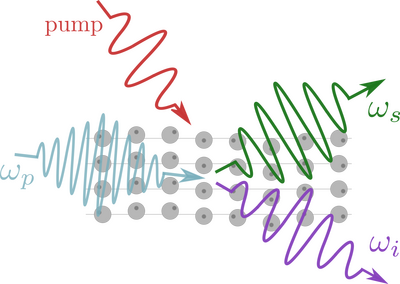Nonlinear x-ray processes
For more than a century already, x-rays provide indispensable insights into materials and their various properties. Most of the established techniques – be it conventional x-ray imaging at the doctor’s office or intricate crystallographic diffraction measurements – are based on linear processes of light-matter-interaction. Only with the advent of x-ray free-electron lasers (XFEL) during the past decades did non-linear x-ray phenomena likewise make an entrance on the scene. This development is comparable to the optical regime, where the introduction of optical lasers paved the way for nonlinear wavemixing techniques. These have since found their applications across a broad range of science and technologies. During a wavemixing process, multiple electromagnetic fields (waves) interact and influence one-another (mixing) within a medium – see Fig. 1 for illustration.

Fig. 1 – Symbolic depiction of wavemixing; here showing four different fields.
In our group, we employ both theoretical and experimental approaches to study such wavemixing processes, which involve – among others – fields at very short wavelength (XUV/x-ray). Adapting methods from different wavelength regimes and developing new techniques alike, we explore possibilities of probing matter beyond the established means of imaging or spectroscopy. Ultimately, we aim to transfer our findings into routine applications providing novel, non-linear x-ray tools.
X-ray optical wavemixing
Of particular interest in this respect are processes of parametric x-ray optical wavemixing (XOWM). These combine one (or more) optical fields with the scattering of x-ray beams. As a result, they promise imaging capabilities similar to regular x-ray diffraction augmented with spectroscopic selectivity that can be tuned via the optical admixture(s). Intriguingly, this provides a method to specifically address valence electrons, which are otherwise challenging to image in isolation. In order to understand XOWM in greater detail, we have developed a theoretical framework based on non-relativistic Quantum Electrodynamics that allows us to formalize a set of wavemixing processes. Enabled by this framework, we can simulate scattering patterns based on theoretical considerations (see Fig. 2) and – more importantly – gain initial interpretations of experimentally observable features as well. Simultaneously, we are pursuing experimental studies at increasingly high resolution to continuously advance our overall picture of XOWM.

Fig. 2 – Energetically resolved scattering patterns for x-ray parametric down-conversion as expected for different sample rotations.
Involved group members: